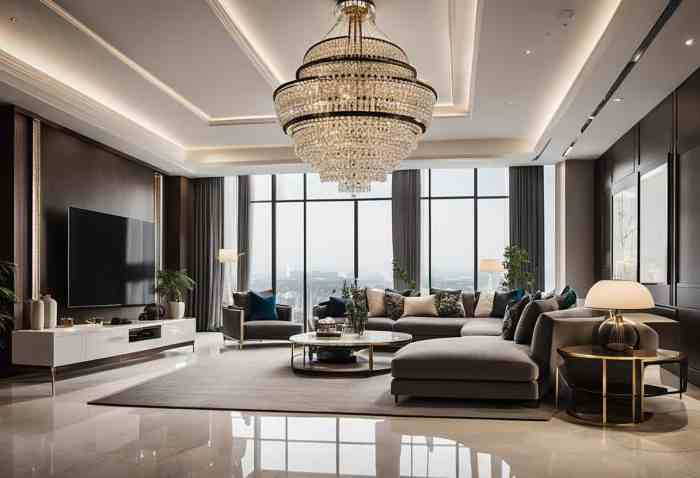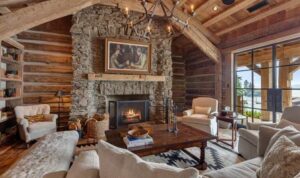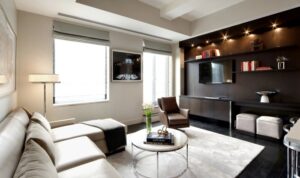Beautiful interior design sets the stage for this enthralling narrative, offering readers a glimpse into a story that is rich in detail and brimming with originality. From the key elements that enhance beauty to the selection of furniture and accessories, this topic delves into the art of creating stunning interiors.
Elements of Beautiful Interior Design

Creating a beautiful interior design involves various key elements that work together harmoniously to enhance the overall aesthetic appeal of a space. From color schemes to lighting, textures, and patterns, each component plays a crucial role in transforming a room into a visually stunning environment.
Color Schemes
Color schemes are essential in interior design as they set the mood and atmosphere of a room. By carefully selecting and combining colors, designers can create a cohesive and visually pleasing space. For example, using complementary colors like blue and orange can create a vibrant and energetic feel, while monochromatic schemes with varying shades of the same color can add a sense of sophistication and elegance.
Lighting
Lighting is a key factor in creating a visually appealing interior design as it not only illuminates the space but also enhances the overall ambiance. By incorporating different lighting sources such as overhead lights, floor lamps, and accent lighting, designers can highlight architectural features, create focal points, and add depth to the room.
Textures and Patterns
Textures and patterns play a significant role in adding visual interest and depth to a room. Incorporating elements like plush rugs, velvet cushions, or textured wallpaper can create a sense of warmth and coziness. Additionally, using patterns such as stripes, geometric shapes, or floral prints can add a touch of personality and style to the space.
Furniture Selection

When it comes to interior design, furniture selection plays a crucial role in creating a cohesive and visually appealing space. The right furniture pieces can elevate the design and tie everything together seamlessly.To ensure that your furniture pieces complement each other in a design, consider the following tips:
Importance of Scale and Proportion
Scale and proportion are key elements to consider when choosing furniture for a space. It is essential to select furniture pieces that are appropriate in size relative to the room and other elements within it. A large sofa in a small living room can overwhelm the space, while small chairs in a spacious dining room can look out of place.
Pay attention to the proportions of each piece to achieve a harmonious balance in the design.
Mixing and Matching Different Furniture Styles
Mixing and matching different furniture styles can add interest and personality to a room. To create a cohesive look, start by selecting a dominant style or theme for the space. Then, incorporate pieces from other styles that complement the dominant one.
For example, pairing a modern sofa with a vintage coffee table can create a unique and eclectic look. Pay attention to the colors, materials, and shapes of the furniture pieces to ensure they work well together.
Incorporating Statement Pieces
Statement pieces are bold and eye-catching furniture items that can add character and drama to a space. Incorporating statement pieces, such as a vibrant accent chair or a sculptural light fixture, can elevate the design and serve as focal points in the room.
When selecting statement pieces, consider the overall aesthetic of the space and choose items that enhance the design without overwhelming it.By following these tips and guidelines, you can select furniture pieces that not only complement each other but also enhance the overall design of your interiors.
Use of Accessories and Decor
Accessories like rugs, artwork, and plants play a crucial role in interior design, adding depth, texture, and personality to a space. They can tie together the overall aesthetic of a room, creating a cohesive and inviting atmosphere.
Significance of Accessories
Accessories such as rugs, artwork, and plants are essential elements in interior design as they add visual interest, color, and texture to a space. They can help define the style of a room and serve as focal points that draw the eye and create a sense of balance and harmony.
Creating Balance and Harmony
- Choose accessories that complement the existing color scheme and style of the room.
- Consider the scale and proportion of the accessories in relation to the furniture and space.
- Use a mix of textures and materials to add depth and visual interest.
Incorporating Personal Touches
Personal touches can be added through accessories like family photos, souvenirs, or handmade items. However, it's important not to overcrowd the space with too many personal items. Select a few meaningful pieces that enhance the overall design without overwhelming the room.
Enhancing Aesthetic with Accessories
- Hang a statement piece of artwork as a focal point in the room.
- Add a cozy rug to define a seating area and bring warmth to the space.
- Introduce plants and greenery to add a touch of nature and freshness to the room.
Spatial Planning and Layout
Effective spatial planning is crucial in achieving a beautiful interior design. It involves strategically organizing the layout of a space to optimize functionality, flow, and aesthetics.
Creating Flow and Functionality
When designing different living spaces, it is essential to consider how people will move through the area and how they will use the space. To create a sense of flow and functionality, ensure there are clear pathways and that furniture is arranged in a way that promotes easy movement and access.
- Use area rugs to define separate zones within an open-concept space.
- Arrange furniture in a way that encourages conversation and interaction.
- Consider the placement of lighting fixtures to ensure adequate illumination throughout the space.
Optimizing Space Utilization
Whether dealing with a small or large room, optimizing space utilization is key to a successful interior design. Here are some tips to make the most of any space:
- Choose multi-functional furniture pieces, such as a sofa bed or storage ottoman, to maximize functionality.
- Utilize vertical space with shelves or wall-mounted storage units.
- Consider furniture placement to create a sense of openness and avoid clutter.
Innovative Layout Designs
There are countless innovative layout designs that can maximize visual appeal in a space. Some examples include:
- Creating a gallery wall to add interest and personality to a room.
- Using mirrors to reflect light and create the illusion of a larger space.
- Implementing a circular seating arrangement to promote intimacy and conversation.
Final Thoughts
Explore the world of beautiful interior design and discover how the right elements can transform any space into a work of art. With a focus on harmony, balance, and creativity, designing your dream interior has never been more exciting.
Answers to Common Questions
How important are color schemes in beautiful interior design?
Color schemes play a crucial role in enhancing the beauty of interior spaces by setting the mood, creating harmony, and adding visual interest.
What is the significance of accessories in interior design?
Accessories like rugs, artwork, and plants add depth and personality to a space, contributing to its overall aesthetic appeal.
Why is spatial planning essential in achieving a beautiful interior design?
Spatial planning ensures that the layout maximizes functionality, flow, and visual appeal, creating a harmonious and well-designed space.


